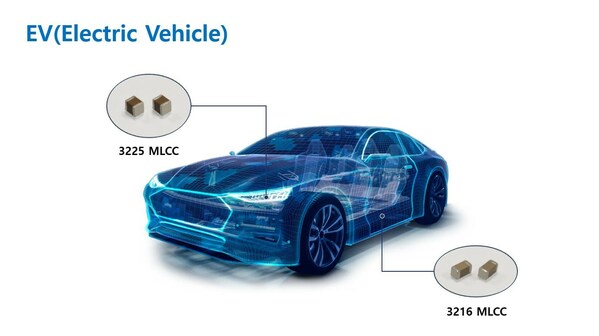- Development of two types of MLCCs applied to electric vehicles…Realization of the industry’s highest capacity among MLCCs with a rated voltage in the 250·100V class * Rated voltage: The maximum voltage that can be withstood without being damaged by the voltage.
– Used in electric systems such as batteries and chargers and LED headlamps, which are key elements of electric vehicles that use high voltage
– Enhanced battery stability and stable energy supplied to semiconductors with high capacity
– Realized the highest capacity in the industry by applying nanoscale atomization technology to the core raw material (ceramic)
– Improved durability against voltage with proprietary raw material surface coating process
- Strengthening the automotive component business by newly establishing dedicated automotive electronic component organizations and expanding the electronic product lineup
– CEO Chang Duckhyun said that "Samsung Electro-Mechanics has established the whole line-up for automotive MLCC by developing electric vehicle products and is transforming into an automotive component company."
SEOUL, South Korea, May 17, 2023 /PRNewswire/ — Samsung Electro-Mechanics announced on the 16th that it has succeeded in realizing the industry’s highest capacity in terms of high-pressure MLCC applicable to electric vehicles and has started market targeting by expanding its line-up for high-end level automotive electronic components.
The MLCCs developed this time are products that have the characteristics of 250V class 33nF (nanofarad) with low capacitance change rate according to temperature and 100V class 10µF (microfarad) for 125℃ and they are products with the industry’s highest capacity in terms of high-pressure MLCC in the same voltage class. Each product is used in electric systems and LED headlamps, which are key devices for electric vehicles.
* Farad (symbol: F): Unit representing electric capacity
Electric vehicles operate based on high-voltage battery systems such as battery management systems (BMS) and on-board chargers (OBC). MLCCs used in electric vehicles must be able to withstand the high output voltages transmitted from the battery for ultra-fast charging and power delivery. In addition, as the number of electronic components used in electric vehicles increases, semiconductors must also have high-capacity characteristics so that they can operate stably.
The 250V class · 33nF product developed this time boasts the highest capacity in the industry at the same voltage level. 22nF was the highest capacity for the existing 250V class products. This product improves battery stability by removing high-frequency noise inside the battery module while having the durability to withstand high voltages.
In addition, the 100V class · 10µF product is used in LED headlamps for electric vehicles and its electric capacity has been doubled compared to the previous product. Semiconductors used in LED headlamps require high power consumption, so high-capacity MLCCs that can store a lot of energy and supply it to semiconductors quickly and stably while having high voltage durability are essential.
In general, it is difficult for MLCCs to satisfy both voltage and capacitance characteristics at the same time. Designing thicker dielectrics to increase voltage characteristics reduces the number of internal electrodes that can be stacked, making it difficult to increase capacity. Samsung Electro-Mechanics has realized high capacity by refining dielectrics as core raw material in the form of nano-level fine powder. The company also explained that its proprietary surface coating method minimizes agglomeration between powders, enabling stable operation at high voltages.
Meanwhile, the MLCCs developed this time satisfies AEC-Q200, a reliability test standard for automotive electronic components, enabling them to be used in other applications such as ADAS, body, chassis, and infotainment in vehicles.
Samsung Electro-Mechanics CEO Chang Duckhyun said that "Samsung Electro-Mechanics has established the whole line-up for automotive MLCC by developing electric vehicle products," and that "Samsung Electro-Mechanics will develop and manufacture core raw materials for MLCCs on its own to enhance technological competitiveness, and expand its market share for electronic device MLCCs by internalizing facilities and strengthening production capacity."
Samsung Electro-Mechanics has been developing and producing MLCCs since 1988 and has the world’s second largest market share in the IT sector. Samsung Electro-Mechanics is strengthening its lineup of high-temperature, high-pressure, and high-reliability electronic device products based on its technological prowess in the ultra-small and ultra-high-capacity MLCC sector, and is expanding its MLCC supply to global automotive component manufacturers and automobile manufacturers.
Samsung Electro-Mechanics has newly established organizations dedicated to automotive electronic components in its major business divisions following the expansion of the automotive electronic components market to continuously develop technologies for automotive electronic components in areas such as MLCC, camera module, and semiconductor package substrate, and is expanding its business proportion. Samsung Electro-Mechanics CEO Chang Duckhyun said at the shareholders’ meeting last March, "Electric vehicles and autonomous driving are opportunities for Samsung Electro-Mechanics," and that "We will emerge as an automotive component company by joining the development trends of automotive electronic components market."


